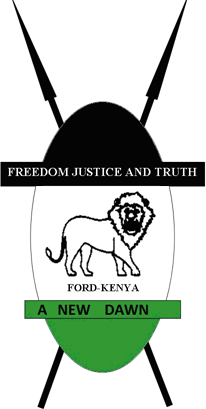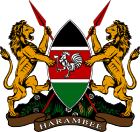
The politics of Kenya take place in a framework of a presidential representative democratic republic, whereby the President of Kenya is both head of state and head of government, and of a multi-party system in accordance with a new constitution passed in 2010.

Emilio Stanley Mwai Kibaki was a Kenyan politician who served as the third President of Kenya from December 2002 until April 2013 and is regarded as one of Kenya's founding fathers.

Stephen Kalonzo Musyoka is a Kenyan politician who was the tenth Vice-President of Kenya from 2008 to 2013. Musyoka served in the government under the late President Daniel arap Moi and was Minister for Foreign Affairs from 1993 until 1998; subsequently, under the late President Mwai Kibaki, he was Minister of Foreign Affairs again from 2003 to 2004, then Minister of the Environment from 2004 to 2005. He was an unsuccessful candidate in the 2007 presidential election, after which he was appointed vice-president by Kibaki in January 2008.
The Liberal Democratic Party was a political party in Kenya.

Elections in Kenya take place within the framework of a multi-party democracy and a presidential system. The President, Senate and National Assembly are directly elected by voters, with elections organised by the Independent Electoral and Boundaries Commission (IEBC).

Forum for the Restoration of Democracy–Kenya (FORD–Kenya) is a Kenyan political party. The party has sat in the government of Kenya once, under the National Rainbow Coalition, from 2003 to 2007, having ended forty years of one party rule. In April 2022, the party joined the Kenya Kwanza coalition for the August 2022 elections, and is headed by Moses Wetangula, the current speaker of the National Assembly of Kenya

His Right Honorable Wycliffe Musalia Mudavadi is a Kenyan politician and land economist who is currently serving as the Prime Cabinet Secretary of Kenya. Until October 2022, he was also the party leader of the Amani National Congress (ANC), one of the founding political parties, of the Kenya Kwanza alliance. He served as the 7th Vice-President of Kenya in 2002 and Deputy Prime Minister (2008–2012), when he resigned to contest for the Presidency in the 2013 Kenyan general election and emerged third. He was the deputy party leader of the Orange Democratic Movement (ODM) (2005–2012) and Party Leader of the United Democratic Forum Party (UDF) from May 2012 to July 2015.

Raila Amolo Odinga is a Kenyan politician, former Member of Parliament (MP) for Langata and businessman who served as the Prime Minister of Kenya from 2008 to 2013. He is assumed to be the Leader of Opposition in Kenya since 2013.

The Prime Minister of Kenya was a post in the Kenyan government. The first Prime Minister of Kenya was Jomo Kenyatta, who became Prime Minister in 1963. In 1964, Kenya became a republic, the post of Prime Minister was abolished and Jomo Kenyatta became President. Following a power-sharing agreement in February 2008, the role was recreated that April and held by Raila Odinga. The position was again abolished by the 2010 Constitution after the 2013 elections.
The Orange Democratic Movement (ODM) is a centre-left political party in Kenya. It is the successor of a grassroots people's movement which was formed during the 2005 Kenyan constitutional referendum campaign. This movement separated in August 2007 into the Orange Democratic Movement Party of Kenya and the Wiper Democratic Movement – Kenya.

John Njoroge Michuki was a Kenyan politician and businessman. He was born at Muguru, village, Iyego Location, Kangema Division in Murang’a District. He was educated in Kenya and abroad. Michuki emerged as one of the prominent and long-serving civil servants and politicians as well as a businessman in Kenya. Michuki served Kenya in various capacities, including Permanent Secretary in the Finance Ministry, Chairman of the Kenya Commercial Bank, Member of Parliament and Cabinet Minister. He was serving his 4th five-year term as a Member of Parliament for Kangema Constituency. Michuki had a reputation as a "ruthless" and efficient manager, and was widely acknowledged as among the best performing ministers in President Kibaki's Government. He was serving as the Minister for Environment and National Resources at the time of his death.

Charity Kaluki Ngilu is a Kenyan politician and the second governor elected for Kitui County. She unsuccessfully vied to be President of the Republic of Kenya in 1997. She served as Minister for Health from 2003 until 2007 and Minister of Water and Irrigation from April 2008 to 2013. She also served as Cabinet Secretary for Land, Housing and Urban Development from 2013 until 2015.

The Wiper Democratic Movement–Kenya (WDM-K), formally Orange Democratic Movement–Kenya (ODM–Kenya), is a political party in Kenya, which originated as a result of the 2005 Kenyan constitutional referendum. It is headed by Kalonzo Musyoka, who ran for president in 2007 and served as the vice-president in the Grand Coalition of Mwai Kibaki and Raila Odinga. He is now a member of the main opposition NASA.

General elections were held in Kenya on 27 December 2007. Voters elected the President, and members of the National Assembly. They coincided with the 2007 Kenyan local elections.
The 2007–2008 Kenyan crisis was a violent political, economic, and humanitarian crisis that erupted in Kenya after former President Mwai Kibaki was declared the winner of the presidential election held on December 27, 2007. Supporters of Kibaki's main opponent in that election, Raila Odinga of the Orange Democratic Movement, alleged electoral manipulation. This position was widely confirmed by international observers, as being perpetrated by both parties in the election. Even the head of the electoral commission himself confirmed that he did not know who had won the elections despite announcing the incumbent as president.
The 9th Parliament of the Republic of Kenya was opened by elected President Mwai Kibaki on February 18, 2003. It was the first time that the formerly-dominant Kenya African National Union of Daniel arap Moi was in the minority. The triumphant NARC, which dominated in the general elections of 2002 was in the majority, led by Kibaki.
The 10th Parliament of Kenya saw the National Assembly opened on 15 January 2008. This following the Orange Democratic Movement (ODM) of Raila Odinga winning a majority in the 2007 parliamentary elections. Raila was a candidate in the presidential elections, which resulted in a controversial victory for Mwai Kibaki of the Party of National Unity. The opening of the parliament was fraught with jeers, cheers and brawls between the opposing parties; Mwai Kibaki was greeted by the ODM members with silence and boos, while Raila was greeted by PNU members with accusations of genocide.

Since Kenya gained independence in 1963, the constitution has been altered many times. During the early years of Kenya's existence, the constitution was abused by the president and the ruling party to gain and consolidate power. This was achieved through the creation of a single-party state, the abolition of secret ballots, and increasing the power and prestige that comes with the presidential position.

A constitutional referendum was held in Kenya on 4 August 2010. Voters were asked whether they approved of a proposed new constitution, which had been passed by the National Assembly on 1 April 2010. The new constitution was seen as a vital step to avoid a repetition of the violent outbursts after the 2007 general elections.

The Constitution of Kenya is the supreme law of the Republic of Kenya. There have been three significant versions of the constitution, with the most recent redraft being enabled in 2010. The 2010 edition replaced the 1963 independence constitution. The constitution was presented to the Attorney General of Kenya on 7 April 2010, officially published on 6 May 2010, and was subjected to a referendum on 4 August 2010. The new Constitution was approved by 67% of Kenyan voters. The constitution was promulgated on 27 August 2010.











